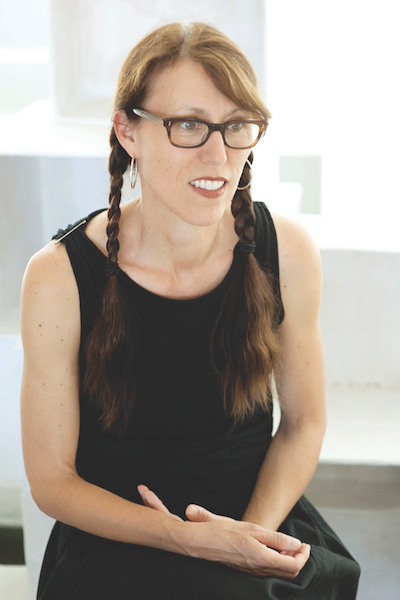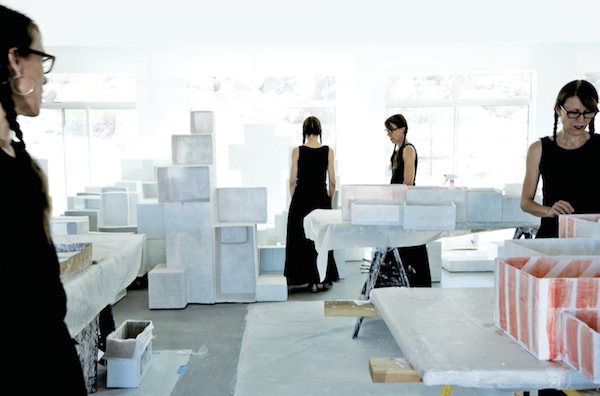
Eye on Design: Andrea Zittel's Aggregated Stacks and the Collection of the Palm Springs Art Museum — a commissioned installation that combines new work by one of the region’s best-known contemporary artists with a fresh look at art, design, photography, and architectural objects and ephemera from the museum’s collection — opens in January at the new Architecture and Design Center, Edwards Harris Pavilion in downtown Palm Springs.
Zittel’s Aggregated Stacks are a variable system of sculptural display units, based on prototypes she made for her own home, executed in a formalized way for the ADC, where the space allows them to spread across its walls and floors. They look less like shelving than models of cliffside dwellings, set pieces from a claymation movie, beehive tunnels writ large, or a mysterious location from a dream.
The artwork was the result of solving a simple household problem.
“I live in the desert where all of my day-to-day necessities are ordered online and delivered to my doorstep in a never-ending stream of carefully packed cardboard boxes,” says Zittel, who lives in Joshua Tree. “I like the ones with special proportions or clearly crisp edges and corners. I found myself stacking the boxes along an empty wall, eventually devising a way to cement this irregular structure together into an integrated unit that reflects a pattern of my own life through consumption.”
It also makes a good place to keep her stuff. By wrapping the boxes in body-casting plaster, Zittel creates durable formations that are arranged in seemingly random but intuitively logical orders of what she calls “fractured grids.”
The Palm Springs Art Museum commissioned an installation of these stacks festooned with objects and materials Zittel selects from the museum’s permanent collection, communicating their own narrative and showcasing unconventional yet functional displays.
“I’m specifically looking at the extensive design and architecture collections,” she says. “I have been looking at everything, from an archive of photographic contact prints taken over several decades chronicling all facets of Palm Springs life to the bold, geometrical patterns in the Native American textile collection. I am particularly interested in everyday objects that don’t necessarily speak to high design so much as to the routines and patterns of day-to-day life. At the same time, I want the work from the collection to have its own relationship to the grid.”
Over the course of her career, Zittel’s artwork has consistently investigated everyday objects that define the way we live — a sensibility the museum ardently shares, and one that for Zittel has blossomed since she moved her family and studio to the High Desert. It makes sense she’d gravitate toward a part of the world where one still sort of has a blank slate in an open-space kind of way — along with a rich lore of rugged, innovative individualism, where nature is suggestive, inescapable, inspirational, and demanding.

Zittel’s personal compound — always expanding, experimenting, hosting creative residencies, and welcoming tour groups — was the natural place for the Aggregated Stacks to materialize. The public/private campus she calls home also features well-appointed guest rooms fashioned from shipping containers, raised topiary gardens occupying industrial delivery drums, and all manner of small-scale agricultural experiments, stretches of undisturbed landscape, and active creative spaces — all conceived with the smallest possible footprint and a commitment to stylish upcycling.
She also founded High Desert Test Sites, sprawling DIY festival phenomenon that promotes personal explorations of this territory and unearthing its histories.
One slice of the heritage of Palm Springs is the great concentration of midcentury modern architecture and design, as well as a robust audience for furnishings, art, and objects of the area.
“The restoration of a midcentury pavilion-style building for the Architecture and Design Center reinforces and serves that interest,” says museum Curator of Architecture and Design Sidney Williams. “The collection, exhibitions, and programs at the ADC also feature contemporary architecture and design.”
Zittel concurs: “Palm Springs has such a wealth of amazing structures and draws so many people interested in design and architecture. Architecture itself is becoming so discursive and representative of large issues in our culture. I like to think of the grid as representative of human idealism or aspiration, and the broken grids of the Aggregated Stacks as having to do with the reality of how those aspirations play out. We crave perfect systems, but when these systems enter real life they become fragmented and multifaceted.”
Like so much of Zittel’s practice, her objects are both dimensional and allegorical, everything carrying on with both its use and its meaning.
“For the last 20 years, my work in one way or another has examined how psychological structures, thought systems, and beliefs manifest as physical objects in the world that we create around ourselves,” the artist says. “I find that we as humans aspire toward the orderly and systematic; however, life itself is quite chaotic. The ultimate reality of these two forces is reflected in the dynamic of this imperfect system where patterns and shapes and rhythms fall in and out of order, or flex to accommodate one another. Making this work has increased my sensitivity to the ordered world, and allowed me to look behind the desire for that order in search of the underlying rationale or belief that created it.”
Eye On Design Andrea Zittel’s Aggregated Stacks and the Collection of the Palm Springs Art Museum, March 14 through July 12, 2015; www.psmuseum.org